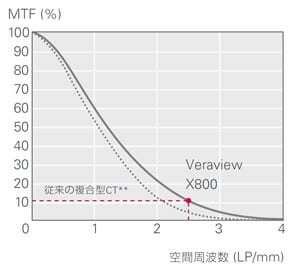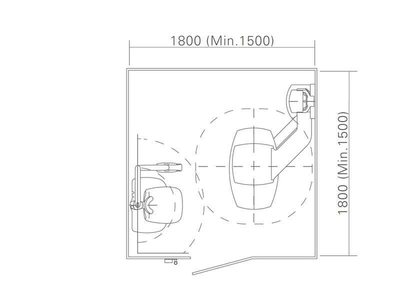Please feel free to use our e-mail back service.
Morita’s dental CBCT is an examination unit enabling the three-dimensional observation and diagnosis of hard tissue in the dental field. It is developed with the concepts of high definition, low dose, small radiation field (FOV selectable), and space-saving design.
High definition
For a three-dimensional resolution, MTF is typically used as a spatial resolution (*). The spatial resolution is represented by an actual measurement value (obtained by actually taking an exposure of a phantom) or a theoretical value (simply calculated from a voxel size). Veraview X800 has achieved the resolution corresponding to the actual measurement value of 2.5 LP/mm 10% MTF or more (voxel size 80 um), in the high-resolution exposure mode of FOV (Field of View: exposure region) Φ40 x H40.

* The spatial resolution shows how small a thing can be recognized spatially. Typically, it is evaluated by a spatial frequency (line pair: LP/mm). This shows how many pairs of light and dark striped patterns contained in a space of 1 mm can be detected. The larger the value, the higher the resolution. MTF (Modulation Transfer Function) is one of the objective evaluation methods for the spatial resolution. It objectively shows how many line pairs can be detected at what contrast level. Typically, it is said that 10% of MTF is sufficient for visual detection. The spatial resolution is not decided only by the voxel size.
** Veraviewepocs 3D series
Low dose
The radiation dose (effective dose) of film panorama and that of the CT exposure of FOV Φ40 x H40 are almost equivalent. The estimated effective doses of each model are shown on the following site:
Effective dose information of Morita’s X-ray units
https://cir.morita-mfg.com/dose_en/
Space-saving design
Veraview X800 can be installed in a space of 1.5 m x 1.5 m.





